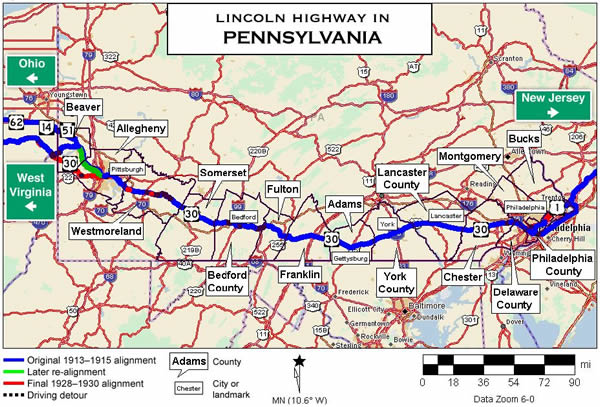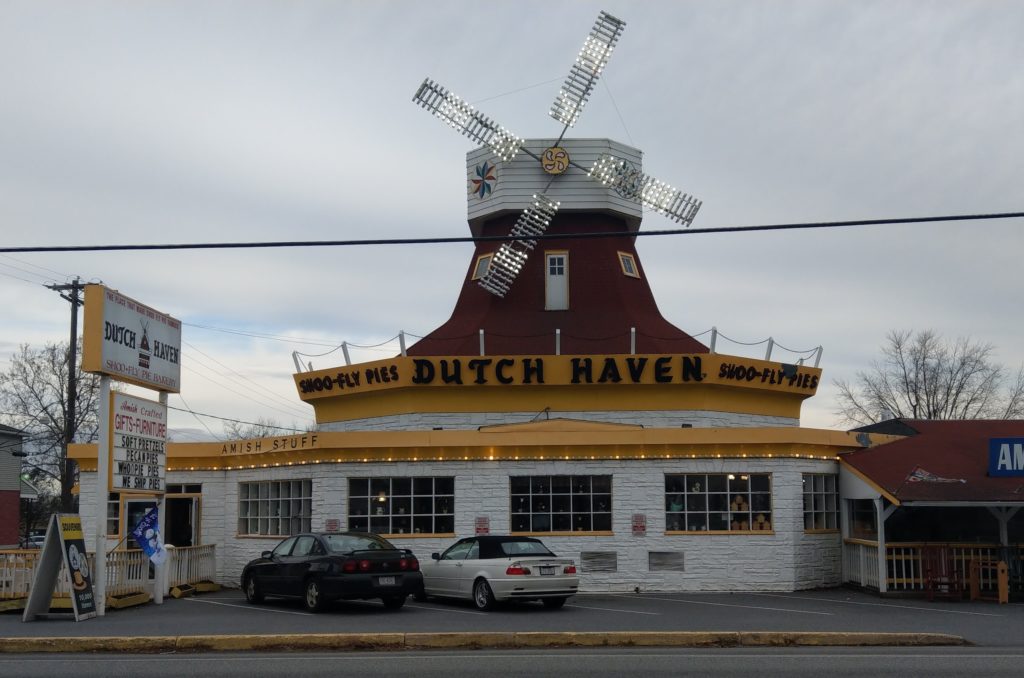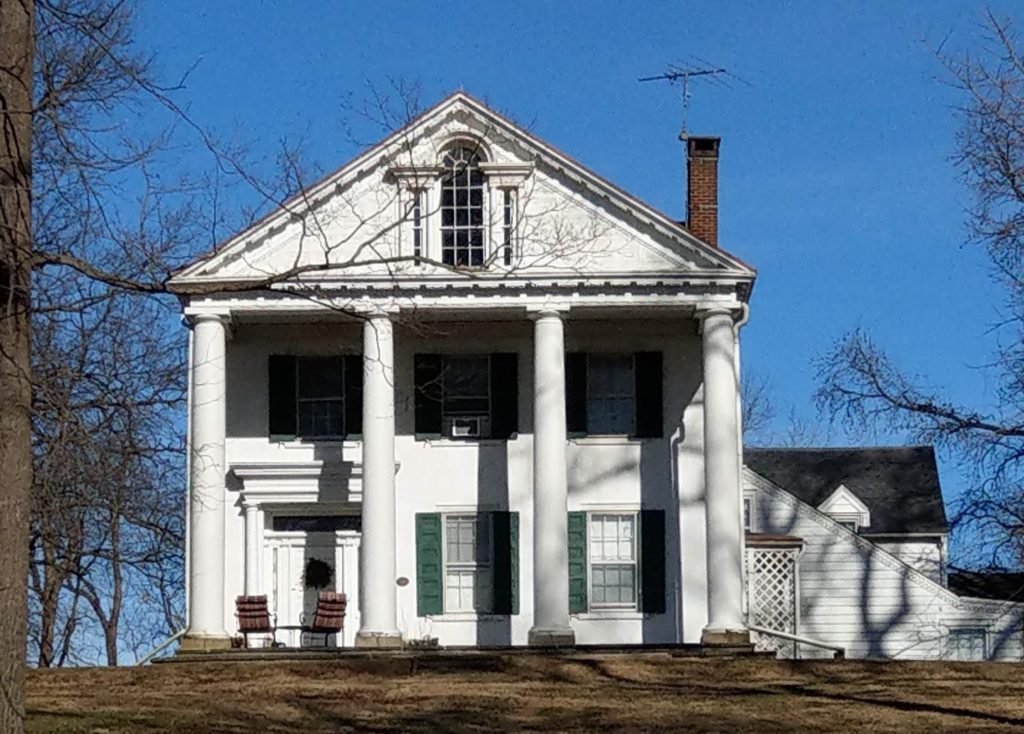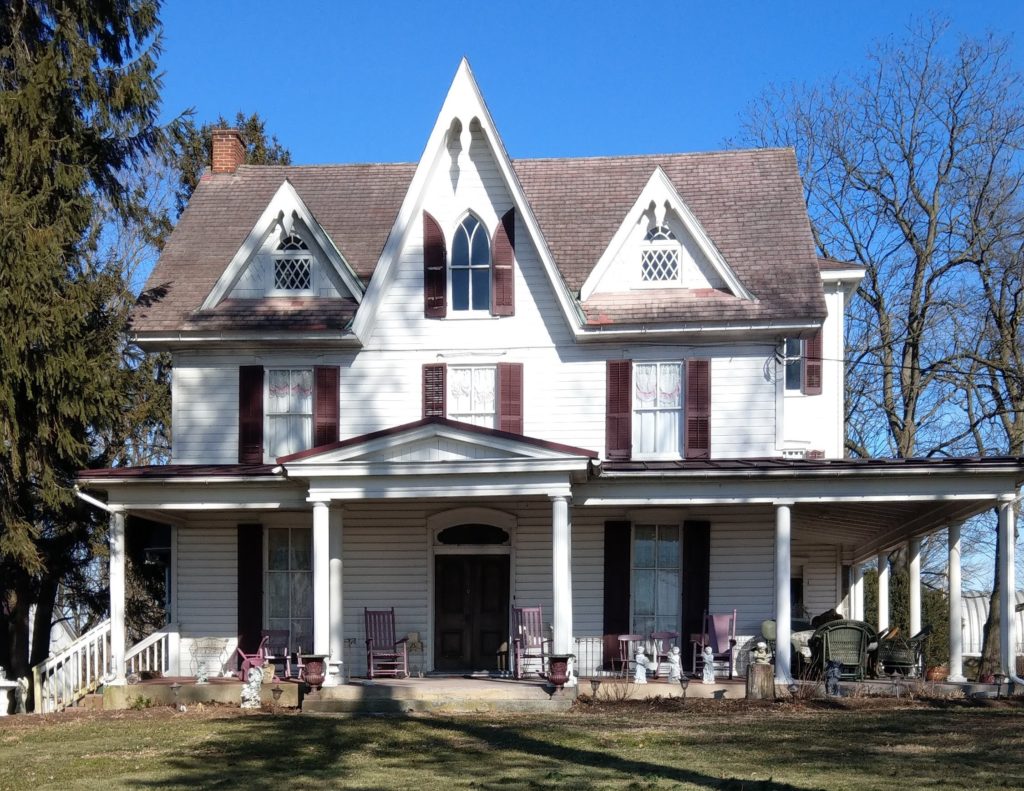The Philadelphia and Lancaster Turnpike is the oldest paved highway in America. It was chartered in 1792 and opened in 1795, connecting farmers in Lancaster County with markets in Philadelphia via a state-of-the-art crushed gravel (or “macadamized”) surface pioneered by Scottish engineer John Loudon Macadam to prevent the wheels of wagons and carriages from sinking into the notorious mud of standard dirt roads.
One hundred and twenty years later, at the dawn of the automobile era, the turnpike became part of America’s very first transcontinental roadway when the Lincoln Highway was inaugurated in 1913. Later designated Route 30, the highway remained the primary route westward from Philadelphia until the opening of the Pennsylvania Turnpike in the 1940s.
Because I live in Lancaster and travel regularly to Philadelphia for work, and because I’m a cheapskate when it comes to tolls, the old Lincoln Highway is one of my preferred driving routes when I can’t take the train. And like most people’s morning commutes, I know the drive like the back of my hand. Or at least I thought I did, until one morning last December, when a startling and disorienting scene appeared before me as I crested a ridge outside Gap, PA.

A backhoe was tearing into an old stone farmhouse on the side of the road and like any preservationist, this is something I never like to see. As I drove past, an equally disturbing realization began to set in. Not only did I have no idea this particular farmhouse had been threatened with demolition, I wasn’t completely sure I had ever really noticed it before!
Scrolling back through the mental pictures of my morning commute, was this house among my navigational landmarks? Now almost gone, could I picture what it used to look like? Did I know its history? I was embarrassed to realize that I wasn’t sure.
In penance, I turned to a higher authority for answers: CRGIS! As readers of this blog hopefully know, CRGIS stands for Cultural Resources Geographic Information System and is Pennsylvania’s digital repository for survey and inventory information on more than 169,000 historic places across the state.

Entering the location of the farmhouse– the intersection of Lincoln Highway East and Newport Road in Salisbury Township– I discovered a Historic Resource Survey Form for the property. According to this 1983 Historic Resource Survey Form (HRSF), the five-bay, two-story limestone farmhouse was built around 1817 by Maxwell Kennedy and his wife Margaret. Maxwell had served in the State Legislature in 1835-36 and ran the adjacent Sign of the Rising Sun Tavern.
While I use CRGIS regularly for work and sing its praises as a teaching tool (see for example my earlier blog post on the subject, it had never occurred to me to practice what I preach in terms of my own daily routines. And while I was too late to fully appreciate this unfortunate farmhouse while it stood, I quickly realized how many other significant landmarks and points of interest have been hiding in plain sight along my morning commute.
Scanning the CRGIS map for more entries along the Lincoln Highway between Lancaster and the Route 30 bypass, I found some entries I knew well (who could miss the classic roadside attraction and National Register-eligible Dutch Haven windmill?), but many others I knew only through peripheral glances or half-registered mental notes (“I should stop and take a picture of that someday….”).

While only one property, White Chimneys, is listed in the National Register of Historic Places, at least three dozen buildings, districts, structures and objects have been determined eligible. And thanks to the PA SHPO’s recent digitization efforts, most of these associated files are now available online.

Inspired by this CRGIS research, I made extra time on my next trip to Philadelphia to stop and appreciate a few of the landmarks I could now put names and dates to, including the intriguing Greek Revival Leaman Mansion (c.1839), the quirky Victorian Gothic Silas Eshelman House (c.1870), the spectacular Queen Anne Cecilia Witmer House (1877) , and, of course, the aforementioned Dutch Haven (1932-1945), because who can resist free samples of shoo-fly pie?

Armed with this new knowledge, I have a newfound appreciation for the history I travel through on my regular commutes along the old Philadelphia and Lancaster Turnpike– a route that features more than two hundred years of “roadside” architecture!
So now I challenge you to “CRGIS your commute.” You might be surprised at what you discover!
This week’s guest contributor is Ben Leech, a historic preservation consultant and architectural illustrator. From 2010 to 2015, he was advocacy director for the Preservation Alliance for Greater Philadelphia. He is a regular contributor to Extant Magazine and Hidden City Daily, and sits on the board of DOCOMOMO-Greater Philadelphia Chapter. He has taught at Temple University, the University of Pennsylvania, Franklin & Marshall College, Philadelphia University, and Rutgers University Camden. In 2017, he founded Archivolt Press and published two postcard books of his sketches, 36 Views of Philadelphia and 36 Views of Lancaster PA.
Comment Policy
PHMC welcomes and encourages topic-related comments on this blog. PHMC reserves the right to remove comments that in PHMC’s discretion do not follow participation guidelines.
Commenters and Comments shall be related to the blog post topic and respectful of others who use this site.
Commenters and Comments shall not: use language that is offensive, inflammatory or provocative (this includes, but is not limited to, using profanity, obscene, or vulgar comments); disparage other commenters or people; condone illegal activity; identify the location of known or suspected archeological sites; post personal information in comments such as addresses, phone numbers, e-mail addresses or other contact details, which may relate to you or other individuals; impersonate or falsely claim to represent a person or an organization; make any commercial endorsement or promotion of any product, service or publication.
If you would like to comment on other topics not related to this blog post but related to PHMC, please fill out the PHMC Contact Us Form.

How does one access CRIGS?
CRGIS was replaced by our new system, PA-SHARE, March 2021. You can access PA-SHARE here: https://share.phmc.pa.gov/pashare/landing. PA SHPO offers instructions for signing in, tutorials, and FAQs on our website at https://www.phmc.pa.gov/PA-SHARE/Pages/default.aspx.
Did all that
typed in Minquas Trail… ended up in Burma!
Is there a system that actually works?
Looking for modern map of the minquas path